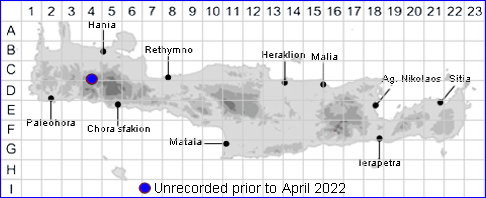
SPECIES DESCRIPTION
VIOLA PHITOSIANIA
Family:- VIOLACEAE/Sect. MELANIUM
Common Names:- None
Synonyms:- None
Meaning:- Viola The Latin name applied to several fragrant plants.
Phitosiana (L) Named after Dimitrios Phitos, professor at the
University of Patras
General description:- Annual, with dense indumentum of short, crisped or
deflexed hairs.
Stem:- 2-10(-20) cm.
Leaves:-
a) 1-3 cm.
b) lowermost orbicular.
c) the others oblong-spathulate, crenately lobed.
2) Stipules:
a) 0·5-1 cm.
b) pinnatipartite with an oblong-spathulate, crenately lobed, shortly stalked,
terminal segment and smaller lateral segments.
Flowers:-
1) Corolla shorter than to slightly longer than the calyx.
2) Calyx appendages 1/6-1/4 as long as the calyx.
3) Lower petal 9-13 mm long including the slender spur 3-5 mm long, much longer
than the calyx appendages.
4) Bracts just below the flower.
5) Flowers 0·4-0·8 cm.
6) Sepals lanceolate, exceeding the corolla.
7) Petals cream-white to yellow with a yellow centre.
Fruit:-
1) Seeds 1.5-1.7 mm
Key features:-
1) Lower petal 9-13 mm long including the slender spur 3-5 mm long, much longer
than the calyx appendages.
Habitat:- Discovered in open tussock-grass in the shade of Crataegus monogyna
trees on the flat bottom of a large doline, with a limestone substrate.1)
Distribution:- Endemic to Greece and is now recorded from all Greek floristic
regions except the North Aegean Islands, the East Aegean Islands and the
Kyklades. First discovered on the Omalos plain W. Crete by Giorgos Palimetakis,
April 2022, ID confirmed by Nicholas. J. Turland. On a subsequent visit during May
a further 122 flowering individuals were observed by Fotis Samaritakis.1)
1) Viola-phitosiana-EuroMed-Checklist-Notulae
Flowering time:- April-May
Photos by:- Fotis Samaritakis
FAMILY AND GENUS DESCRIPTIONS
VIOLACEAE
General description:- Small shrubs or herbs.
Leaves:- Alternate, stipulate, usually undivided.
Flowers:- Hermaphrodite, solitary. Sepals 5, persistent. Petals 5, free. Stamens 5,
introrse, uniting distally (connivent) round the ovary. Ovary superior, single-celled
(unilocular), with 3 placentas and numerous ovules.
Fruit:- A 3-valved capsule. Seeds endospermic.
VIOLA
Leaves:- Petiolate. Sepals prolonged into short appendages below the point of their
insertion.
The term rosulate is used for plants with a loose, basal rosette of 3-5 petiolate
leaves from the axils of which arise flowering branches, and the term arosulate for
plants in which this basal rosette is lacking.
Flowers:- Corolla zygomorphic, the lower petal spurred. Connectives of stamens
with an apical appendage; the 2 lower stamens spurred. Style thickened above;
stigma of various shapes (beaked, bilobed, capitate).
Flower lengths are measured from apex of spur to apex of lower petal, or from apex
of upper to apex of lower petal, whichever is the longer.
Fruit:- Seeds with an oily appendage (elaiosome).
Sect. MELANIUM
General description:- Herbaceous.
Leaves:- Stipules usually large, leaf-like, often divided.
Flowers:- Lateral petals directed upwards. Open flowers blue or yellow; self
pollinating (cleistogamous) flowers not produced. Style bent, knee-like (geniculate)
at the base, pin-headed (capitate), with wide stigmatic aperture.
